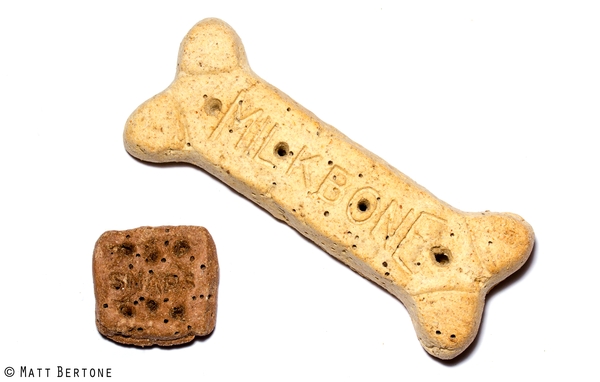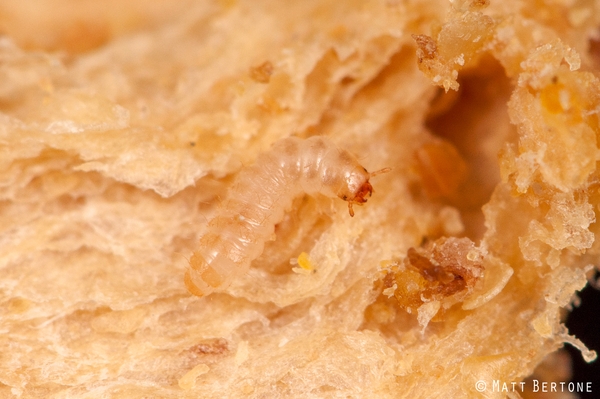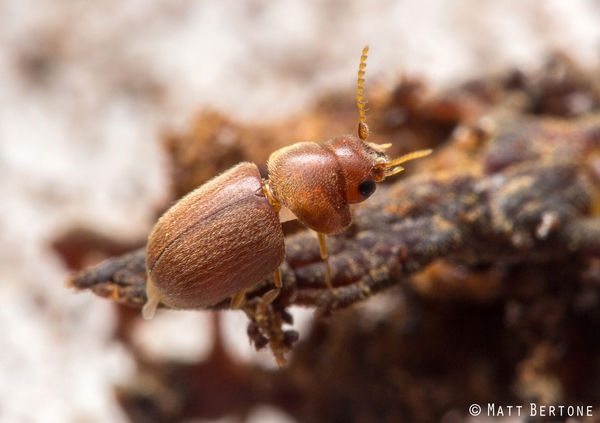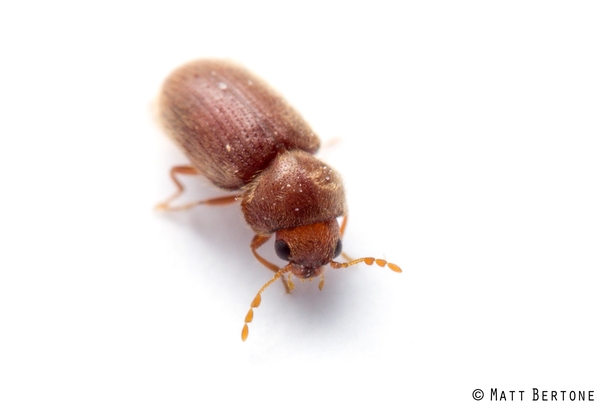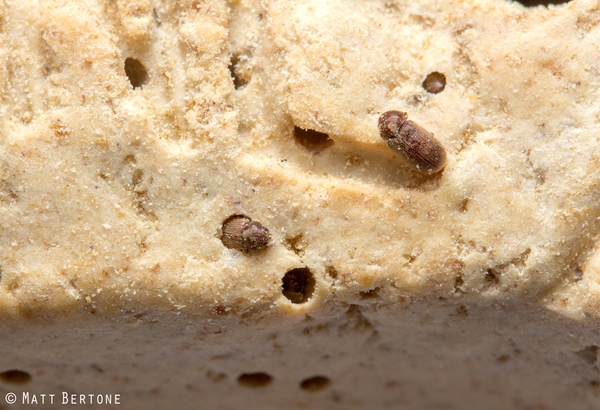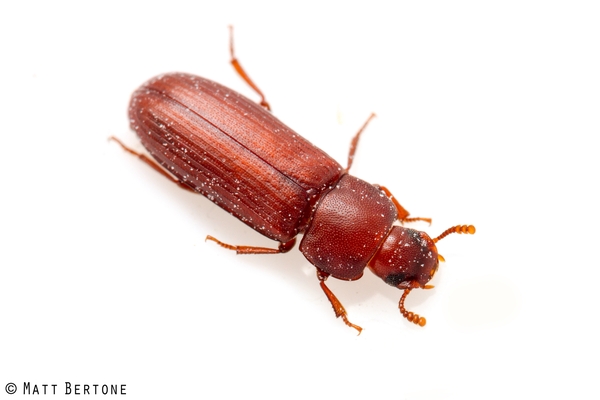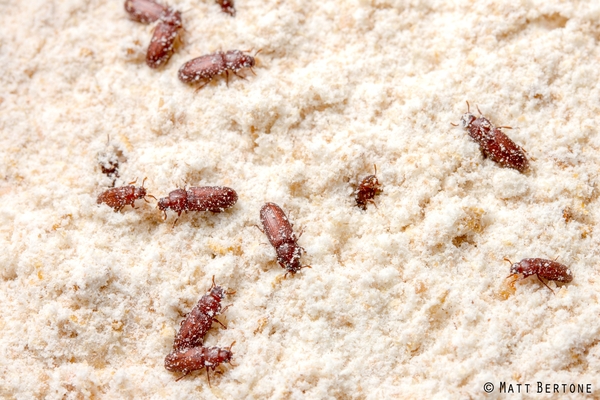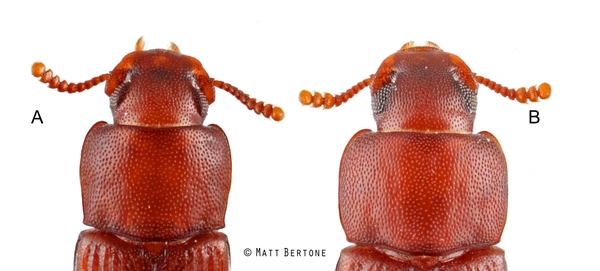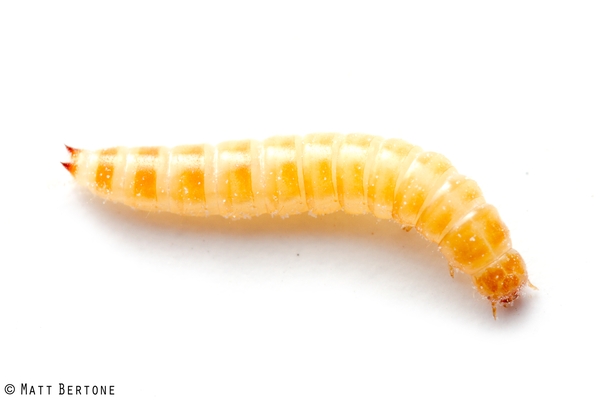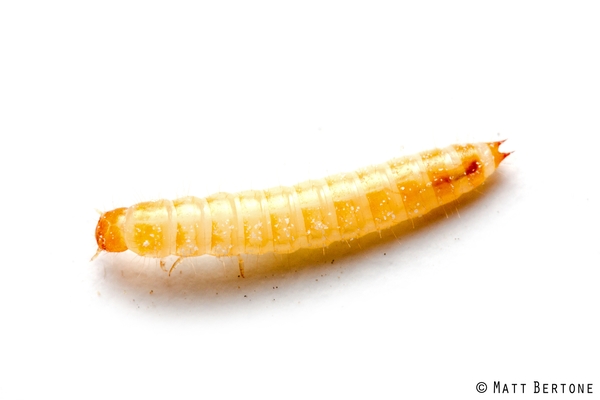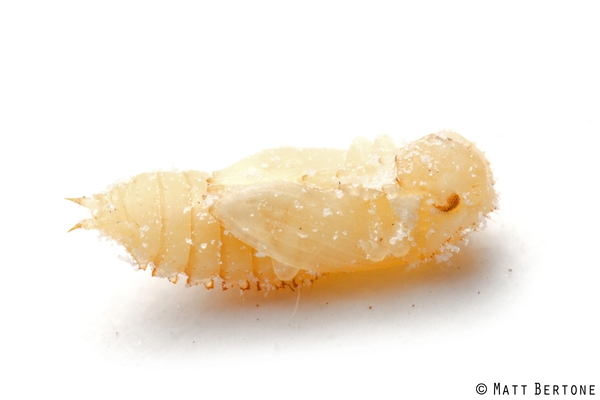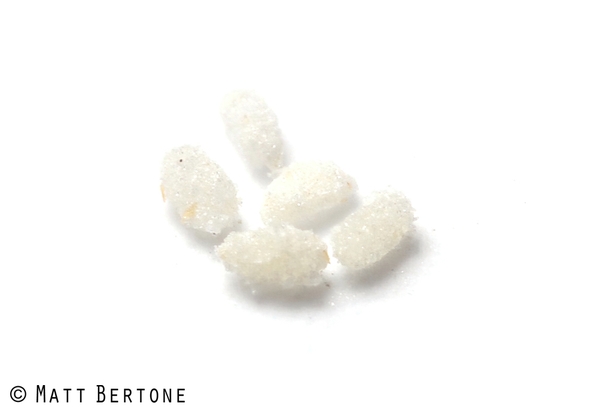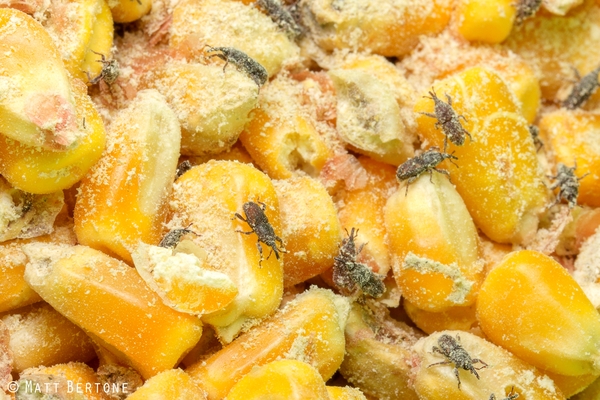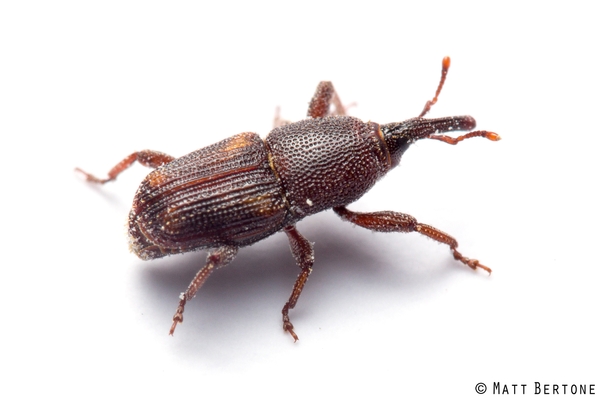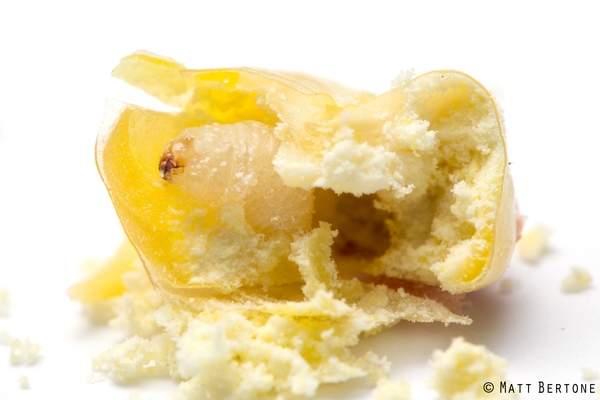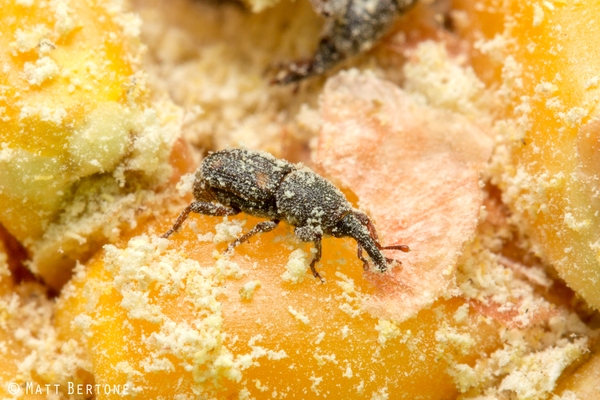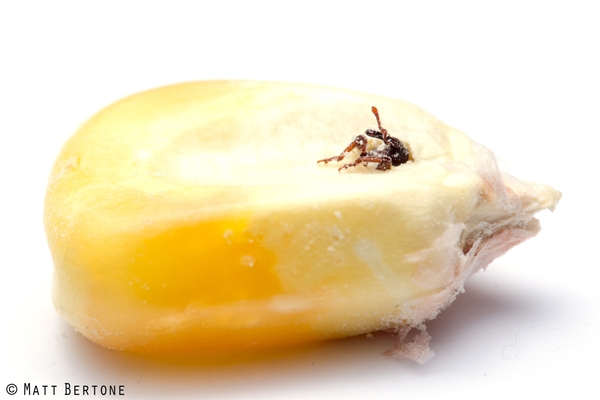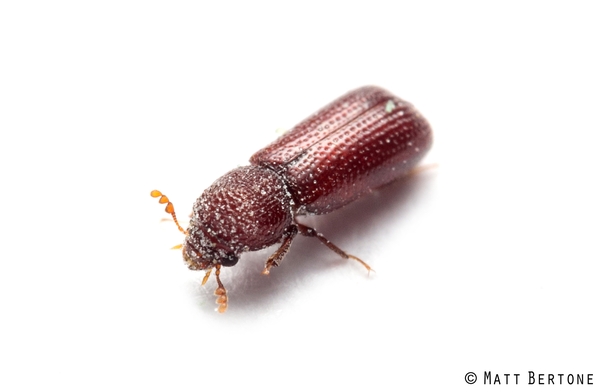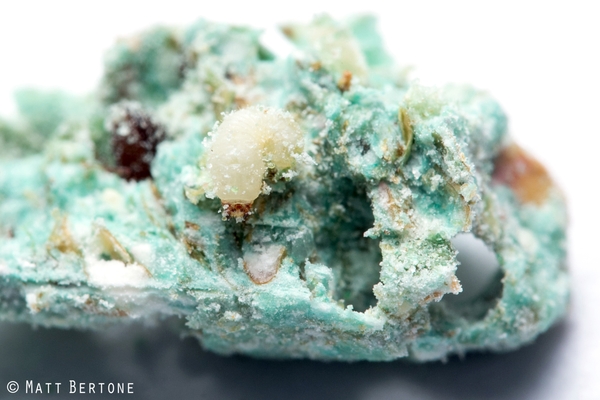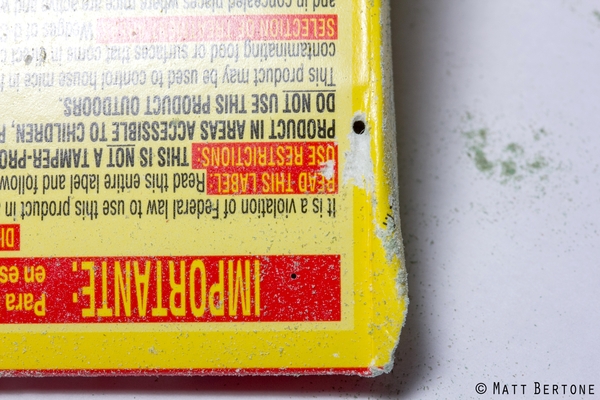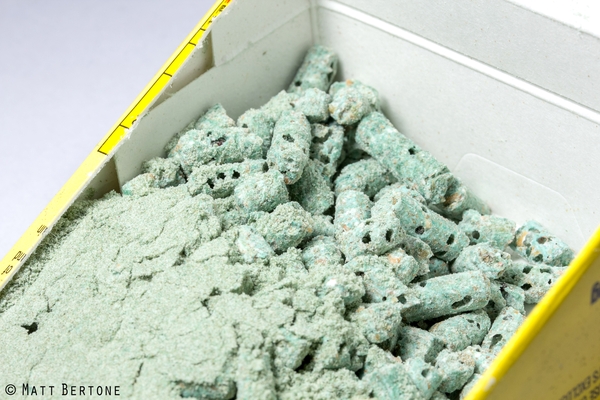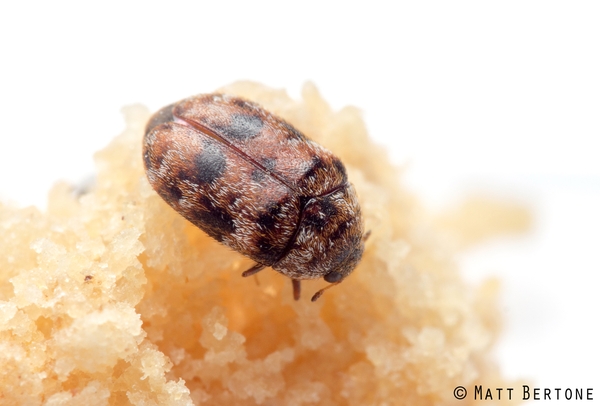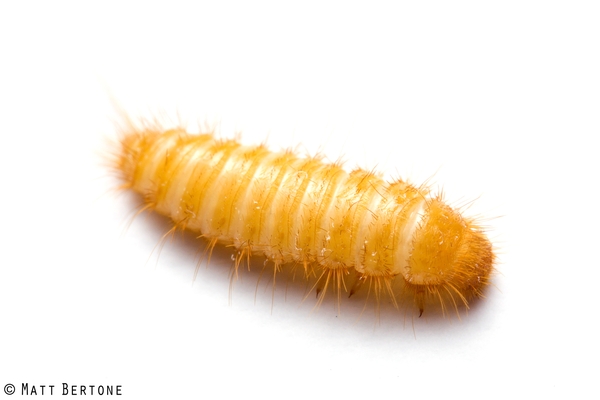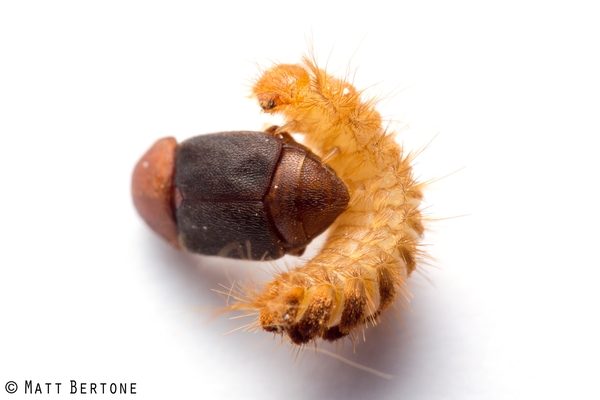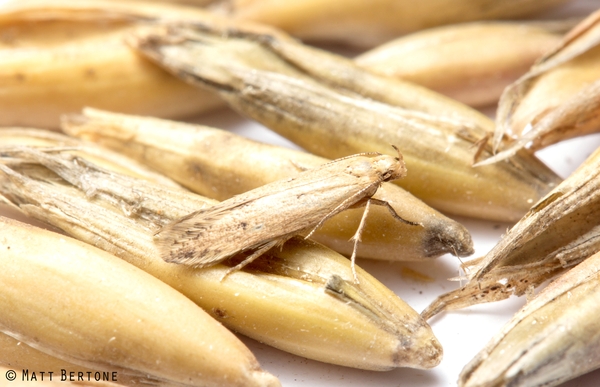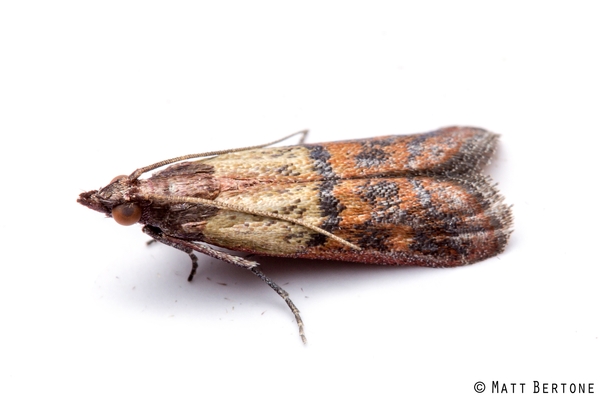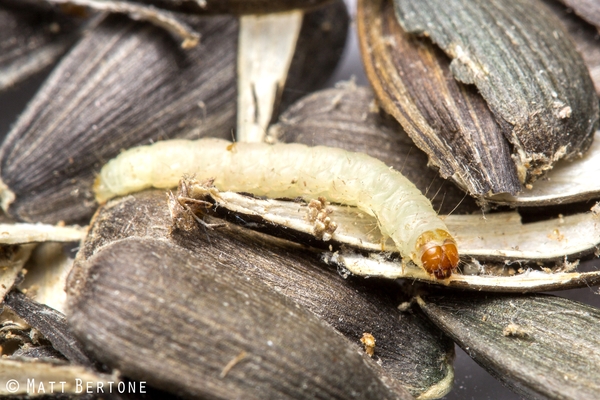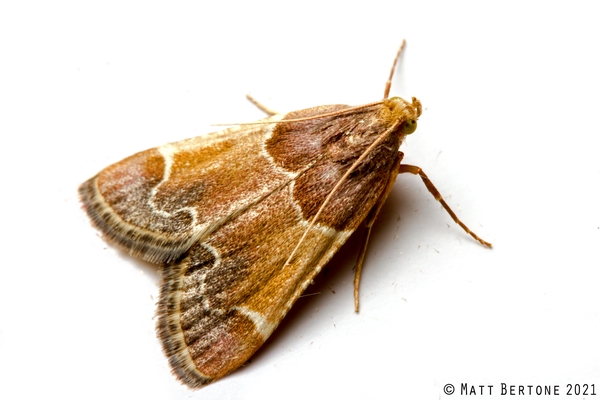Introduction
Most people will encounter a stored product pest at one time or another—they are periodically found in nearly every home (Figure 1). When a moth or beetle is repeatedly spotted in the home on a cyclical or repeating time frame, that is a good indication of a stored product infestation. Pantry pests are most often found in, near, or around the kitchen. However, they can theoretically be found in any area of the home as long as there is a food source available. For instance, some pantry pests will infest seeds stored by animals and even the carcasses of dead animals (like mice or birds) that may be located in the attic, wall voids, and other areas away from the kitchen. Private residences are not the only places susceptible to pantry pest issues—commercial kitchens, food handling facilities, and grocery stores are also common areas where infestations begin. In fact, many individuals struggling with a pantry pest problem are affected because they received a food product that was infested prior to purchase (Figure 2). Stored product pests are problematic because they can breed continuously and produce multiple generations annually, even in less than ideal environmental conditions, as long as a suitable food source is available. The result? Damaged and inedible food, often associated with nuisance-level numbers of the pest in the home.
Biology
Stored product pests are diverse in their biology and habits, so we will discuss the biology of each specific pest in the sections below. However, experts do separate stored product pests into groups based on the way that they feed. Knowing how pests consume foods can assist in identification as damage is assessed. The damage caused during feeding is induced largely by the larval (juvenile, immature, etc.) life stage of each pest in question; adults are mostly responsible for breeding. All of these pests have complete metamorphosis, which includes eggs (inactive), larvae (feed, cause damage), pupae (inactive), and adults (reproduce and sometimes feed, typically observed moving around or flying).
- Internal feeders damage the inside of a grain kernel and typically require an entire kernel for development. Example: Granary and rice weevils.
- External feeders feed from the outside of a grain kernel and move inward. Example: Indianmeal moths.
There are other types of stored product pests too, like scavengers and secondary pests (for example, those that feed on molds present on foods and grains), but for brevity they are not described in this article.
Pests of Importance
As stated above, this list is not exhaustive. The pests listed below are some of the most commonly encountered stored product pests in commercial and residential settings.
Beetles
- Grain beetles (sawtoothed grain beetle, merchant grain beetle)
- Cigarette beetles
- Drugstore beetles
- Red and confused flour beetles
- Granary weevils
- Rice weevils
- Lesser grain borers
- Warehouse beetles
Moths
Grain Beetles
Generally speaking, grain beetles (Genus Oryzaephilus) infest grains, as the name suggests. They are usually dark red or dark brown in color. The two most commonly encountered grain beetles are the sawtoothed grain beetle and the merchant grain beetle. These beetles are difficult to distinguish from one another and have similar habits; each species will be described in more detail below. Note that there are other species within this genus that can be managed in much the same way as other stored product pests, and their biology and other habits will resemble the two species below. The specific grain of preference may differ among species.
Sawtoothed Grain Beetle
Sawtoothed grain beetles, Oryzaephilus surinamensis, get their name from the row of large “teeth” located on the sides of their thorax near the head. They are one of the most important pests in the home as well as in grocery stores. They are found globally.
Adults are approximately 1/10” long. They are very flat and can easily find their way into cracks and crevices. They are one of the easier stored product pests to spot due to the saw-like features behind their head. They also have three distinct ridges on the top of their thorax (area behind the head and in front of the abdomen). They do not fly, though they do have wings. Larvae are about 1/8” in length and whitish yellow in color with a brown head. They are wriggly and might remind you of a grub or large maggot. This is true of all of the beetle larvae described in this fact sheet.
Females can lay ~40-300 eggs in a two to five-month period. Depending on temperature, eggs hatch in three to 17 days. Their life cycle takes 30-50 days and adults live, on average, six to ten months. Sawtoothed grain beetles will attack cereals, breads, pasta, chocolate, tobacco and other grain-based products. Their flat body allows them to penetrate imperfectly sealed products with ease.
Merchant Grain Beetle
Merchant grain beetles, Oryzaephilus mercator, as previously stated, are very similar to sawtoothed grain beetles in their appearance, biology, and habits. In fact, for many years it was thought that they were one species until genetics separated them into two. They are approximately ⅛” in length with a flat body. They are dark brown in color and also have saw-like features behind the head (Figure 3). They are known to fly and have well-developed wings–unlike sawtoothed grain beetles. Larvae are yellowish-white and very small (Figure 4).
Females can lay up to 200 eggs over the course of several months. Eggs are typically laid in small clusters in food materials. Eggs hatch quickly, often within a few days. The life cycle can be as short as 30 days or as long as one year depending on the temperature (the warmer it is, the faster they develop). Adults can live for several months. They attack similar foods to sawtoothed grain beetles, but they prefer foods that are more oily, such as nuts. This pest will also attack cereals like oats, rice flours, cake mixes, macaroni, and cookies. Note that they cannot attack undamaged kernels.
Cigarette Beetles
The cigarette beetle, Lasioderma serricorne, also known as the tobacco beetle, is responsible for severe damage to stored grains and seeds, packaged foods, and other animal/plant-based items. They are frequently encountered in the home and are attracted to light.
Adults are quite small, only about 1/8” in length (Figure 5). They are round/oval in shape and, from above, the head is hidden by a small plate that covers the first section of the body. The covers of their wings have fine hairs all over them. When you startle a cigarette beetle adult, they will often tuck in their head and legs and remain completely still. They have serrated (like the teeth of a saw) antennae and smooth covers over their wings. They reside in dim areas, but fly in bright light and are most active at dusk and night. Their life cycle requires 30-90 days and the minimum temperature for growth and development of juveniles is 65 degrees F (Figure 6). Adults will live approximately 23-28 days.
Cigarette beetles attack an array of foodstuffs including paprika, dog food, cigars/tobacco products, coffee beans, dried fruits and vegetables, peanuts, raisins, rice, yeast, furniture stuffing, dried fish, and dried insects. Dry dog food and paprika are two of the most commonly attacked food items in the home. Inspections should be very thorough due to the wide array of foods they attack and the small size of this pest.
Drugstore Beetles
Drugstore beetles, Stegobium paniceum, are closely related to cigarette beetles, both being members of the group Ptinidae/Anobiidae. They look similar to cigarette beetles but are more elongate and have deep pits on the covers of the wings that are arranged in rows, whereas the wing covers on cigarette beetles are smooth (Figure 7). They also have antennae that are different: the final three segments are much larger than other segments in the antennae. They got their name because they were, historically, a serious pest of herbs used as medicines in early apothecaries. They are found globally.
Female drugstore beetles lay eggs in the food materials they attack. The eggs only need a few days to hatch. The entire life cycle takes around seven months. They attack multiple items around the home such as medicines, hair, leather, bread, cereals, and condiments (Figure 8). They can even attack books and paper products.
Red and Confused Flour Beetles
The red flour beetle, Tribolium castaneum (Figure 9), and the confused flour beetle, Tribolium confusum (Figure 10), are similar in appearance and often confused for one another (thus the name for T. confusum). They attack only damaged grains—they are unable to feed on whole kernels or undamaged grains. They can attack a wide array of products, especially dried fruits, spices, chocolate, flour, cereals, crackers, cake mixes, pet foods, and dried flowers (Figure 11).
The red flour beetle is typically found in the southern U.S., while the confused flour beetle is predominantly found in the North. They are both small (1/8”) insects that are reddish brown in color. Red and confused flour beetles can be distinguished from one another by the antennae. The antenna of the red flour beetle ends in a 3-segmented club and the sides of the thorax are slightly curved, whereas the confused flour beetle has no apparent club on the antennae and the sides of the thorax are straighter (Figure 12). Both of these beetles can breed throughout the year in warmer areas. The life cycle takes 40 to 90 days. Adults are long-lived, and can live for up to three years. All forms (egg, larvae, pupae, adults) may be found in infested grain products at the same time. See Figure 13, Figure 14, and Figure 15.
Females of both species lay approximately 300-500 clear/white eggs on food materials or in cracks and crevices that contain food (Figure 16). Both species are also attracted to light, but the confused flour beetle does not fly (the red flour beetle does). Both red and confused flour beetles impart a grayish tint to foods they infest, and they also cause a disagreeable odor in infested products. Additionally, their presence can encourage mold growth.
Granary Weevils
Granary weevils, Sitophilus granarius, are found in cooler climates and in the United States they can be found from North Carolina upward. Adults are a shiny, reddish-brown color but occasionally they can look nearly black. They are approximately 1/8”-1/4” in length. Like most weevils, they have an elongated “snout” that can be seen on the head. Although the mouthparts may look threatening, they do not bite people. Larvae are legless and white with a darker head. They have a humpbacked shape.
Females make a hole in a kernel of grain to lay their eggs and then they seal the opening with a jelly-like material. An adult female granary weevil can lay more than 200 eggs when conditions are good. The life cycle can take one to five months, depending on temperature. Adults can live for seven to eight months, on average.
Because the granary weevil does not fly, they are typically moved from place to place by humans. This also means that they are confined to one area when they are moved. Larvae require an entire kernel for development. They attack all kinds of grains and grain products. Like cigarette beetles, they will tuck the legs and play dead when disturbed. Unlike many other stored product pests, the adults are not attracted to light.
Rice Weevils
Rice weevils, Sitophilus oryzae, are considered by some to be the most important stored product pest because they cause severe economic loss for food producers (Figure 17). This pest is reddish brown in color (Figure 18), similar to the granary weevil. However, rice weevils have four pale marks on the wing covers. Additionally, rice weevils have fully developed wings and can fly. The larvae (Figure 19) are legless and humpbacked, like the granary weevil.
Females bore into grain kernels to lay eggs and seal the hole with a jelly-like material. They can lay 3-400 eggs in their lifetime, but are less active in cooler temperatures. The egg-to-egg life cycle (the time for bugs to grow from egg to adult and then lay new eggs) may be as short as 32 days and adults can live for three to six months.
This pest is typically confined to grain stored north of North Carolina. In the south, adult rice weevils will fly from stored grain products and infest new grain crops in the field (Figure 20). Infestations then arise in storage. Rice weevils can attack corn, wheat, rice, beans, nuts, rye, cotton, wheat, grapes, and other stored foods (Figure 21). They will also feed on some fruits. Adults play dead when startled, are attracted to light, and prefer higher temperature and humidity (80+ degrees F and 75-90% relative humidity).
Please note, there is a third species of weevil that was, for some time, indistinguishable from the rice weevil. Maize weevils (S. zeamais) are incredibly similar in appearance and habit to rice weevils, but are now considered their own species based on genetics and internal morphology. Due to the similarity in appearance and habit, we will not describe them separately here. If you would like assistance with identification, please reach out to an extension specialist.
Lesser Grain Borers
Lesser grain borers, Rhyzopertha dominica (Figure 22), are beetles that bore into grains. They are of tropical origin but are now distributed worldwide and likely moved through trade and commerce. They prefer warmer climates and in the north are confined to heated structures. Adults are approximately ⅛” in length, dark brown to black in color, and the head is bent downward so that it is not visible from above. Larvae are whitish in color, but the head and thoracic legs (claws) are darker (Figure 23).
Females lay eggs on the food material that larvae will consume. They can lay hundreds of eggs over their lifetime. Eggs hatch in a few days and the life cycle takes around 60 days to complete. In warm weather, the life cycle may take as few as 30 days. Unlike some other stored product pests, the adults of this species are long-lived and will feed extensively, causing damage. They prefer whole seeds, with corn and wheat being attacked preferentially. They may also infest tobacco, nuts, spices, cork, dried meat, leather, book bindings, pharmaceuticals, and pelleted rodent baits (Figure 24 and Figure 25). They often cause a displeasing odor in materials that they infest. The adults of this species can fly and they are attracted to light.
Warehouse Beetles
Warehouse beetles, Trogoderma variable (Figure 26), get their name from their propensity to invade warehouses. This pest leads to some medical concerns, as the ingestion of larvae or the shed skins of larvae can cause gastrointestinal irritation. In fact, many infestations are identified because of the shed skins left behind by larvae. These beetles are ⅛” in length and are brownish black in color with yellow to yellowish brown markings. The larvae are yellowish white when they are young and develop a darker shade as they age (Figure 27). They are covered in long hairs that are sharp and needlelike. These hairs are what cause irritation when they are ingested.
Adult females can lay 90+ eggs over several days. This insect can move from egg to adult in 30-40 days depending on the temperature. The adults are excellent fliers and can disperse over a wide area. This beetle can infest a wide array of stored products. Examples include cake mixes, candy, cereals, cocoa, cookies, dog food, egg noodles, grits, macaroni, spices, yeast, etc. They will also infest products of animal origin such as dead vertebrates, fish meal, and powdered milk (Figure 28). They preferentially attack high-protein foods and the larvae prefer to live in dark areas.
Angoumois Grain Moths
The Angoumois grain moth, Sitotroga cerealella (Figure 29), is named for the French province where it was first found destroying grain. These months were introduced into the United States in 1728. After granary and rice weevils, they are considered the most serious pest of stored grain. They are found in homes, but are a bigger threat to commercial food/grain storage.
Adult moths are buff or tan in color, thin in shape, and approximately 1/3” long. The edges of the wing have a fringed and fluffy appearance. Larvae are 1/4” in length, white in color, have a yellowish head and reddish-brown mouthparts. Adult females will lay an average of 40 eggs on or near grain. The eggs turn red with time and hatch in four to eight days. The entire life cycle takes five to seven weeks on average. Larvae require a whole kernel or caked food materials for development. Notably, these moths cause a noticeable, rancid smell in the foods they infest.
Angoumois grain moths will attack rye corn, oats, rice and a wide array of seeds. They prefer damp grain as opposed to old, dry grain and will only attack complete kernels. They can fly, and are attracted to light.
Indianmeal Moths
Indianmeal moths, Plodia interpunctella (Figure 30), are probably the most frequently encountered stored product pest in the home and in grocery stores. Adults are approximately 5/8-3/4” in length. They have pale tan and gray wings at the front, but the outer 2/3 of the wing is reddish-brown with a coppery tone. This pest was so named because it was first found feeding on meal made of “Indian corn”, or maize. The larvae are usually off-white, but can also be pink, brown, or even green depending on the food source they have infested (Figure 31). Unlike some other stored product pests, the larvae have well-developed prolegs that allow them to move away from their food source for pupation (going from a wriggly larva to an inactive, non-feeding state). The pupae can be found so far away from food that this moth is sometimes mistaken for a fabric pest (clothes moths). In pantries, larvae will often climb to shelves away from the food they infested, which makes it difficult to identify the food source that is contaminated in some cases.
Adult females can lay 100-400 eggs on average within a period of 1-18 days. When the eggs hatch, larvae will feed inside a tunnel-shaped case that it makes from excrement and silk. These cases have a webbed appearance. The life cycle of this pest can take anywhere from 25-135 days. When larvae are feeding, they produce a lot of webbing across the infested foods which makes damage easily identifiable (Figure 32).
This pest will attack biscuits, chocolate, candy, bird seed, dry dog food, dried fruits, dried vegetables, flour, cornmeal, corn, crackers, seeds (including bird seed), nuts, and other foodstuffs (Figure 33). As stated previously, larvae and adults are often mistaken for clothes moths, so proper identification is very important for this pest. Adults are attracted to, and will fly to, light.
Meal Moths
Meal moths, Pyralis farinalis (Figure 34), should not be confused with Indianmeal moths (described above), because control methods for one will not always work for the other. They do have similar habits and attack similar foods, but Indianmeal moths have specific pheromones (chemical scents that relay specific messages within a species) that are not attractive to meal moths. This is important when it comes to management using attractive, baited traps (described in the “management” section).
Meal moths are relatively large–they can measure up to ½” in length. The forewings are distinctly patterned with a pale or brush color bordered with a reddish base. The center of the wing is bordered with a wavy white line. The hindwing also has the same distinct pattern. They are found worldwide, but are more common in temperate regions. Larvae will attack wheat, barley, oats, corn, peas, beans, flour, nuts, dried food, cereals, hay, and potatoes. The adults do not feed. Females lay anywhere from 2-400 eggs within larval food sources, but larvae will move away from infested items to pupate, similarly to Indianmeal moths. The developmental time to adulthood can be as few as six weeks in ideal conditions. These pests are often found in moldy foods or foods with a high moisture content. They are often thought to be associated with unsanitary conditions. Larval activity can be identified by the presence of silk or webbing on contaminated foods, as well as by the presence of shed skins and frass (excrement).
Mediterranean Flour Moth
Mediterranean flour moths, Ephestia kuehniella, are gray moths with black zig-zag lines across the front of the wings. This pest rests in a very distinct way—the front of the body is raised and the back-end slopes downward. The larvae are pinkish white with a darker head.
Females can lay hundreds of eggs that hatch quickly (within three to five days). Larvae damage food by spinning silken threads into it, producing a sticky, matted substance. Pupation (when larvae become inactive and turn into adults) occurs in food materials that are clean and away from infested materials. The life cycle usually takes eight to ten weeks.
Adults cause no damage. Larvae, however, will attack flour, cereal, bran, beans, dog food, nuts, seeds, chocolate, and other stored products. Adults will fly and are attracted to lights.
Almond Moths
Almond moths, Cadra cautella, are another relatively large moth species measuring up to ½” in length. Their wings are bi-colored and are light gray/light brown in color. The wings may also have light wavy markings on them. Adult moths are short-lived and only survive for 10-14 days. In this short time, though, females can lay over 200 eggs. Eggs hatch in a matter of days and larvae can pupate in less than one month.
This pest prefers dried fruits, nuts, confectionery, and cereal products. In fact, this pest gets its name for its preference for nuts, including almonds. This pest is often confused with the Indianmeal moth even though it is more similar in appearance to the Mediterranean flour moth. Adults are active fliers and are often observed moving at dusk. Signs of an infestation often include webbing on infested products, frass (excrement) the size of ground pepper, dead adults, and the shed skins of larvae. Although they are cosmopolitan, they do prefer heated facilities and more tropical environments.
Management of Pantry Pests
Stored product pest control is best achieved using an integrated pest management plan (a data-based plan with multiple parts) with the following components:
1. Prevention and Monitoring
Preventing the established presence of stored product pests is the easiest way to mitigate lengthy infestations. Try the following:
-
Inspect all incoming items for pests; look for silk and webbing in stored foods
-
Visually inspect raw commodities
-
Make sure buildings have adequate ventilation
-
Some pests can be monitored with pheromone traps (Indianmeal moth) otherwise, sticky traps can be used to assess pest presence
-
Pheromone monitors can be used for foods in-transit
-
Find and quickly eliminate infested items
-
Keep meals and flours refrigerated prior to use
-
Use all products within two to four months of acquisition
-
In the home, do not forget to inspect “odd” or obscure items (bean bags, homemade heating pads with rice inside, art projects using food items, etc.)
-
If you cannot find the infested product inside, move outdoors–bird feeders and other caches of animal foods can harbor stored product pests
2. Sanitation
Decreased levels of sanitation affects the effectiveness of chemical and other treatment methods. Sanitation is arguably one of the most important aspects of store product pest control. The following tips can help:
-
Remove spilled food and crumbs from kitchens, pantries, and other areas where food is stored or consumed
-
Remove or treat any infested stored products
-
Discard old or expired food products
-
Vacuum and clean pantries as well as cracks and crevices where food particles may accumulate frequently
3. Improvement in food storage
Stored product pests can easily penetrate thin or broken packaging. To prevent this:
-
Try to use all dried foods within two to four months of purchase
-
Replace torn or ripped bags
-
Regularly inspect stored products for packaging failures
-
Store foods in airtight, sealed containers
-
If in a commercial facility, store food on pallets 18” away from walls and off of the floor
4. Stock Rotation
Store foods on a schedule whenever possible. Try the following:
-
Sell or use oldest foods prior to newer products
-
Adopt a “first in, first out” policy
5. Ventilation
Ventilation is critical for keeping humidity levels low, as well as creating an environment where pests do not easily enter. Be sure to:
-
Keep moisture content in stored foods as low as possible
-
Keep air pressure slightly positive
-
Install air curtains when necessary and ensure they are functioning properly
-
Close doors and windows quickly after use
6. Control
Sometimes, intervention and action is necessary for an infestation. In this case:
-
Insect light traps can be used for pests attracted to light (monitoring only, do not rely on these to eliminate a population)
-
Fumigation can be used in commercial facilities or for pests that lay eggs inside kernels
-
Residual chemical applications can be used, when necessary, but should be a last resort
-
Pheromone or food attractant traps can be used to monitor and suppress pest populations
-
Heating or cooling to a proper temperature to kill all life stages can be applied to products that can withstand temperature changes
-
Be sure to clean the area after treatment to remove dead or dying insects
For more information on stored product pest management or for help designing an integrated pest management plan, feel free to contact an Urban and Structural Entomology Extension Specialist at North Carolina State University. For assistance with identification, contact a diagnostician at our Plant Disease and Insect Clinic.
Publication date: July 15, 2022
N.C. Cooperative Extension prohibits discrimination and harassment regardless of age, color, disability, family and marital status, gender identity, national origin, political beliefs, race, religion, sex (including pregnancy), sexual orientation and veteran status.


